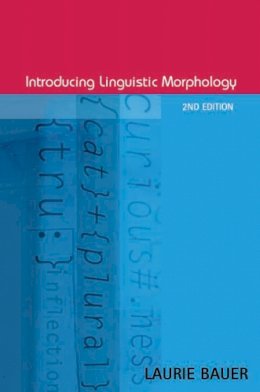10%OFF

Stock image for illustration purposes only - book cover, edition or condition may vary.
Introducing Linguistic Morphology
Laurie Bauer
€ 38.99
€ 35.10
FREE Delivery in Ireland
Description for Introducing Linguistic Morphology
Paperback. An expanded and updated new edition of this best-selling introduction to linguistic morphology. The text guides the reader from the very first principles of the internal structure of words through to advanced issues of current controversy. Num Pages: 384 pages, glossary. BIC Classification: CFK. Category: (P) Professional & Vocational; (UP) Postgraduate, Research & Scholarly; (UU) Undergraduate. Dimension: 215 x 138 x 23. Weight in Grams: 464.
An expanded and updated new edition of this best-selling introduction to linguistic morphology. The text guides the reader from the very first principles of the internal structure of words through to advanced issues of current controversy. The first part of the book introduces basic concepts, with the help of examples from a range of familiar and exotic languages. The second section highlights particularly important topics, and discusses them in more detail. These include the definition of the word-form, productivity, the vexed problems of inflection versus derivation and the nature of the morpheme, and the position of morphology in relation to ... Read more
An expanded and updated new edition of this best-selling introduction to linguistic morphology. The text guides the reader from the very first principles of the internal structure of words through to advanced issues of current controversy. The first part of the book introduces basic concepts, with the help of examples from a range of familiar and exotic languages. The second section highlights particularly important topics, and discusses them in more detail. These include the definition of the word-form, productivity, the vexed problems of inflection versus derivation and the nature of the morpheme, and the position of morphology in relation to ... Read more
Product Details
Publisher
Edinburgh University Press
Format
Paperback
Publication date
2003
Condition
New
Number of Pages
376
Place of Publication
Edinburgh, United Kingdom
ISBN
9780748617050
SKU
V9780748617050
Shipping Time
Usually ships in 5 to 9 working days
Ref
99-50
About Laurie Bauer
Laurie Bauer is Professor of Linguistics at the Victoria University of Wellington. He is an Editor of the journal Word Structure.
Reviews for Introducing Linguistic Morphology
This revision of Laurie Bauer's popular textbook is most welcome. Like the first edition it's clear, reliable and interesting, but it's been updated to take account of the new interest in morphology. New chapters provide an excellent way into recent work informed by non-linear phonology, by diachronic typology and - most interesting of all - by psycholinguistics. Anyone who wants ... Read more
